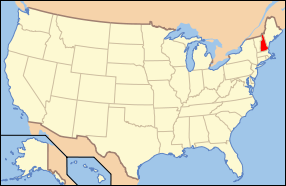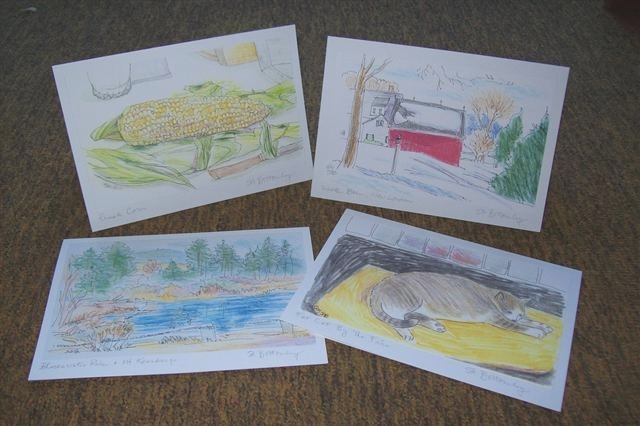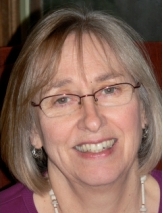 This is the pastry case at the full block Italian food emporium in New York called Eataly. The place was crowded but too early in the day, evidently, for many people to be buying sweets and desserts. Which means I could see clearly the untouched assortment from a few feet away. No, we didn’t buy any. Next time.
This is the pastry case at the full block Italian food emporium in New York called Eataly. The place was crowded but too early in the day, evidently, for many people to be buying sweets and desserts. Which means I could see clearly the untouched assortment from a few feet away. No, we didn’t buy any. Next time. We took the train south to New York City to see our daughter and her husband run in the marathon. Here we have the view from our rented apartment in Park Slope, Brooklyn. A subway entrance is across the street, and on the far side, the famed Brooklyn brownstones. The beautiful building material is sandstone naturally tinted by iron deposits.
We took the train south to New York City to see our daughter and her husband run in the marathon. Here we have the view from our rented apartment in Park Slope, Brooklyn. A subway entrance is across the street, and on the far side, the famed Brooklyn brownstones. The beautiful building material is sandstone naturally tinted by iron deposits. A drawing from memory of some of the 45,000 runners in the NYC marathon. I believe this explains why we failed to see our family members as they ran by. We were probably at a moment of severe distraction. We had never seen a marathon before, so we didn’t realize that runners consume bananas at mile 7, and throw the peels down. That many many runners wear costumes. That most have their first names written on their shirts. This allows the bystanders to shout out personal encouragement.
A drawing from memory of some of the 45,000 runners in the NYC marathon. I believe this explains why we failed to see our family members as they ran by. We were probably at a moment of severe distraction. We had never seen a marathon before, so we didn’t realize that runners consume bananas at mile 7, and throw the peels down. That many many runners wear costumes. That most have their first names written on their shirts. This allows the bystanders to shout out personal encouragement.The runner with the flag is the Chilean miner, running proudly and strongly. The truck in front of him records his every step. The couple at the upper left got married during the course of the 26 mile event. Yes! I also drew the Statue of Liberty, a ballerina in her tutu, and the Blues Brothers. And a wheelchair athlete in the lower right. It was inspiring to watch. We watched in 3 locations, never seeing our family, then walked our way through lovely Central Park to the finish line.
 I love this view on Main Street, New London, New Hampshire. There are about 6 layers of mountains that look ever more blue as they recede in the distance. They are not tall mountains, just beautiful ones. Old mountains with trees to the tops. It is hard to know which animals will be in the field when I pass by. On this day, sheep, llamas, and donkeys. I just drew a sampling.
I love this view on Main Street, New London, New Hampshire. There are about 6 layers of mountains that look ever more blue as they recede in the distance. They are not tall mountains, just beautiful ones. Old mountains with trees to the tops. It is hard to know which animals will be in the field when I pass by. On this day, sheep, llamas, and donkeys. I just drew a sampling.I always say that my car stops here by the side of the road all by itself.
 I say that everyone in our town has a good view of Mount Kearsarge, and that includes the animals. I think alpacas are very cute. With their topknots, big eyes, and long eyelashes, I think they all look like Lucy Ricardo.
I say that everyone in our town has a good view of Mount Kearsarge, and that includes the animals. I think alpacas are very cute. With their topknots, big eyes, and long eyelashes, I think they all look like Lucy Ricardo. One day we drove to Beverly, Massachusetts to the Montserrat College of Art. The main building is the brick one in the rear of the drawing. Originally a junior high school, it now provides classroom and studio space for a generation of up and coming artists, and includes a fine gallery open to the public. I loved the very yellow leaves against the yellow house. We came here to hear a lecture by Gabi Campanario, the founder of Urban Sketchers. He has a weekly sketch/article in the Seattle Times. It was great to meet him. He has done a lot to reinvigorate the old tradition of artists as observers and recorders.
One day we drove to Beverly, Massachusetts to the Montserrat College of Art. The main building is the brick one in the rear of the drawing. Originally a junior high school, it now provides classroom and studio space for a generation of up and coming artists, and includes a fine gallery open to the public. I loved the very yellow leaves against the yellow house. We came here to hear a lecture by Gabi Campanario, the founder of Urban Sketchers. He has a weekly sketch/article in the Seattle Times. It was great to meet him. He has done a lot to reinvigorate the old tradition of artists as observers and recorders.There was a wonderful exhibit in the gallery of artists’ drawings and sketchbooks organized, I believe, by Fred Lynch, who is a professor of illustration at the college and a major contributor to Urban Sketchers.
 This is the Blackwater River as it flows through the nearby town of Wilmot Flat. You see a reflection of Mount Kearsarge in the water. As much as I love the brightest colors of fall in New England, I also enjoy the more subtle colors of very late fall, just before the first snow. Copper browns, wine reds, soft golds, and purples.
This is the Blackwater River as it flows through the nearby town of Wilmot Flat. You see a reflection of Mount Kearsarge in the water. As much as I love the brightest colors of fall in New England, I also enjoy the more subtle colors of very late fall, just before the first snow. Copper browns, wine reds, soft golds, and purples. In another part of Wilmot stands their town library. It is attached to the town hall, but I couldn’t fit that into the frame of the drawing. I did get in Bog Mountain, off in the distance. On the right side of the drawing you see the old sheds with stalls for horses and carriages. Above each stall is the name of the family that used this space. They are all empty now, but ready for the next Sunday church service. Of course now all the people walk or come by car. Time has just frozen here. I find this oddly touching. Such a reverence for the past, and the families that have come before us.
In another part of Wilmot stands their town library. It is attached to the town hall, but I couldn’t fit that into the frame of the drawing. I did get in Bog Mountain, off in the distance. On the right side of the drawing you see the old sheds with stalls for horses and carriages. Above each stall is the name of the family that used this space. They are all empty now, but ready for the next Sunday church service. Of course now all the people walk or come by car. Time has just frozen here. I find this oddly touching. Such a reverence for the past, and the families that have come before us. Here I drew, from memory a very quick sketch of Sarah Josepha Hale, as portrayed by Sharon Wood. She has on a lace cap with side ribbons, over her ringlets. At her throat she wears a cameo brooch. Lace peeks out of the cuff of her bell sleeves. Her voluminous black dress is satin, and rustles when she moves.
Here I drew, from memory a very quick sketch of Sarah Josepha Hale, as portrayed by Sharon Wood. She has on a lace cap with side ribbons, over her ringlets. At her throat she wears a cameo brooch. Lace peeks out of the cuff of her bell sleeves. Her voluminous black dress is satin, and rustles when she moves.But who was Sarah Josepha Hale and why is Sharon Wood portraying her? Where to start! We enjoy very much the presentations sponsored by the New Hampshire Humanities Council. Experienced and entertaining speakers present a subject for an hour or so. Many of the speakers are professors at nearby colleges (many with books to sell), and others are independent historians. Many are storytellers and humorists.
Some like Sharon Wood and her husband Steve (who resembles and indeed portrays Abraham Lincoln) are historians and also re-enactors. You can learn more about them at their Web site.
Sarah Josepha Hale (1788-1879) was born in nearby Newport, New Hampshire. She was widowed with five small children, and became a writer to support herself. She wrote novels, poems, and magazine articles. She wrote the children’s poem Mary Had a Little Lamb.
Most notably she was the editor of the magazine Godey’s Lady’s Book for 40 years, and advanced the careers of American writers, both male and female.
This month Sharon Wood presented Hale as a persistent promoter of Thanksgiving as a national holiday. She wrote countless letters, including correspondence to 5 presidents. Abraham Lincoln was won over by her appeals and declared it so in 1863, during the American Civil War.
Most notably she was the editor of the magazine Godey’s Lady’s Book for 40 years, and advanced the careers of American writers, both male and female.
This month Sharon Wood presented Hale as a persistent promoter of Thanksgiving as a national holiday. She wrote countless letters, including correspondence to 5 presidents. Abraham Lincoln was won over by her appeals and declared it so in 1863, during the American Civil War.
 This doll came into our house recently, when my mother moved from Massachusetts to Wisconsin to be near my sister and her family.
This doll came into our house recently, when my mother moved from Massachusetts to Wisconsin to be near my sister and her family.I don’t collect dolls or know much about them, but she has some appeal to me. I am guessing she is over 100 years old. On the back of her skull are the words “Made In Germany”. Her body is porcelain and fully jointed. Her shoes are of pale blue leather of exquisite detail. Her knee socks are knitted with an argyle pattern. The clothing is machine stitched with the tiniest stitches I have ever seen.
Her dark brown eyes open and close and she is what I call ‘an eyebrow doll’. She has long dark expressive eyebrows. Lovely, but I have yet to see an actual blond child with adult sized dark eyebrows. None the less, it speaks of the fashion of the era. Her mouth is open with two tiny teeth. I couldn’t draw this successfully...she looked like a beaver every time I tried. So I closed her mouth. I also fluffed up her hair a bit and added a bow on her head. I tried to imagine what she looked like new, under the tree, on Christmas day. And what little girl was thrilled to unwrap her.




